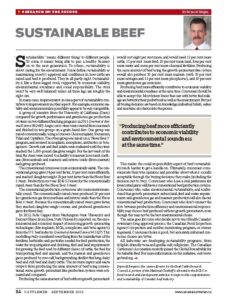Sustainable Beef
This article written by Dr. Reynold Bergen, BCRC Science Director, originally appeared in the September 2013 issue of Canadian Cattlemen magazine and is reprinted on the BCRC Blog with permission of the publisher.
“Sustainability” means different things to different people. To some, it means being able to pass a healthy business on to the next generation. To others, sustainability is about caring for the environment. Some define sustainability as maintaining society’s approval and confidence in how cattle are raised and beef is produced. They’re all partly right. Sustainability is like a three legged stool, supported by economic viability, environmental soundness and social responsibility. The stool won’t be very well balanced unless all three legs are roughly the right size.
In many cases, improvements in one aspect of sustainability contribute to improvements in other aspects. For example, economic viability and environmental responsibility appear to be very compatible.
A group of scientists from the University of California (Davis) compared the growth performance and greenhouse gas production of steers on two different finishing programs in 2011 (Journal of Animal Science 89:2643). Angus-cross steers were sourced from one ranch and finished in two groups on a grain-based diet. One group was raised conventionally, using a Synovex Choice implant, Rumensin, Tylan and Optaflexx. The other group was raised on a “Never Ever 3” program, and received no implants, ionophores, antibiotics or beta-agonists. Growth rate and feed intake were evaluated until the steers reached the 1300lb slaughter weight. For the last week of the trial, the steers were moved to a facility to measure how much methane (from animals and manure) and nitrous oxide (from manure) each group produced.
The conventional system was more economically viable. The conventional group grew 34% faster, 33% more efficiently, and reached slaughter weight 29% faster than the Never Ever 3 steers. Production cost was $142.52 lower for the conventionally raised steers than for the Never Ever 3 steers.
The conventional production system was also more environmentally sound. The conventionally raised steers produced 28% less greenhouse gas from methane and nitrous oxide than the Never ever 3 steers. Because the conventionally raised steers grew faster, they reached slaughter weight sooner, and produced greenhouse gases for fewer days.
In 2012, Jude Capper from Washington State University and Dermot Hayes from Iowa State University reported on the environmental and economic impact of removing growth promoting technologies (like implants, MGA, ionophores, and beta-agonists) from the US beef industry (Journal of Animal Science 90:3527). This modeling study considered everything from the manufacture of the fertilizer, herbicides and pesticides needed for feed production, the water for crop irrigation and drinking, feed and land requirements for growing the feed used by different classes of cattle, the fuel for transporting feed and animals, and the manure and greenhouse gases produced by cow-calf, backgrounding, feedlot finishing, dairy beef and cull beef and dairy cattle. The resource inputs and waste outputs from producing the same amount of beef using conventional vs. growth-promotant free production systems were estimated and compared.
Producing the same amount of beef without growth promotants would cost 8% more, and would need 12% more cattle, 11% more feed, 10% more land, 4% more water and 7% more chemical fertilizer. Producing the same amount of beef using the growth-promotant free system would also produce 10% more manure (with 10% more nitrogen and 11% more phosphorus), and 10% more greenhouse gas emissions.
Producing beef more efficiently contributes to economic viability and environmental soundness at the same time. Consumers should be able to accept this. Most drivers know that cars with better fuel mileage are better for their pocketbook as well as the environment. But not all buying decisions are based on knowledge; individual beliefs, values and emotions also factor into the process.
This makes the social responsibility aspect of beef sustainability much harder to get a handle on. Ultimately, consumers communicate their true opinions and priorities about what is socially acceptable through the buying decisions they make (including the decision not to buy). Consumers who have a real preference for lower retail prices will favor conventional beef production systems. Consumers who value environmental sustainability, and understand that growth promotants reduce land, feed and water requirements and greenhouse gas and manure production will also favor conventional beef production. Consumers who don’t connect the dots between production efficiency and environmental responsibility may choose beef produced without growth promotants, even though this may not be the best environmental choice.
The same goes for some who decide not to trust Health Canada’s veterinary drug approval process, the Canadian Food Inspection Agency’s inspection and residue monitoring program, or science in general. Consumer choice is good, but accurately informed consumer choices are better.
All industries are developing sustainability programs, from dolphin-friendly tuna and gorilla-safe cell phones. The Canadian Cattlemen’s Association recently joined the Global Roundtable for Sustainable Beef. For more information on this initiative, visit grsbeef.org.
Learn more
Explaining Growth Promotants Used in Feedlot Cattle
BCRC Blog – January 14, 2013
Environmental Footprint of Beef Production
BeefResearch.ca
Click here to subscribe to the BCRC Blog and receive email notifications when new content is posted.
The sharing or reprinting of BCRC Blog articles is typically welcome and encouraged, however this article requires permission of the original publisher.
We welcome your questions, comments and suggestions. Contact us directly or generate public discussion by posting your thoughts below.
